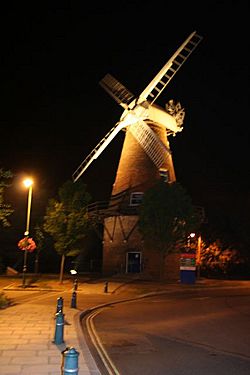Rayleigh Windmill facts for kids
Quick facts for kids Rayleigh Mill |
|
|---|---|

The floodlit mill, July 2006
|
|
| Origin | |
| Mill name | Rayleigh Mill |
| Mill location | TQ 807 910 |
| Coordinates | 51°35′17″N 0°36′25″E / 51.588°N 0.607°E |
| Operator(s) | Rochford District Council |
| Year built | 1809 |
| Information | |
| Purpose | Corn mill |
| Type | Tower mill |
| Storeys | Six storeys |
| No. of sails | Four sails |
| Type of sails | Two Spring sails and two Common sails |
| Windshaft | Cast iron |
| Winding | Fantail |
| Fantail blades | Six blades |
| Auxiliary power | steam engine, then an oil engine, then an electric motor |
| No. of pairs of millstones | Three pairs |
The Rayleigh Windmill is a historic Tower mill located in Rayleigh, Essex, England. It is a special building, protected as a Grade II listed site. Today, it has been carefully restored and serves as a museum, helping people learn about its past.
Contents
History of Rayleigh Windmill
Building the Mill
The Rayleigh Windmill was built in 1809. It was made for Thomas Higgs, who was a timber merchant in Rayleigh. A few years later, in 1815, Higgs had money troubles and went bankrupt. The windmill was then sold to William Hart in 1817.
Changes in Ownership
Over the years, the windmill had several owners. William Hart sold it to George Britton in 1845. Later, in 1869, George's sons, John and Samuel, took over the mill. They spent about £150 to fix it up. However, the Britton brothers left Rayleigh in 1884 and also faced financial difficulties by 1886.
The Last Wind-Powered Days
Thomas James Brown became the next miller. He was the last person to operate the windmill using only wind power, which stopped around 1907. After that, the top part of the mill (the cap) and its sails were removed around 1909. The mill then used other types of power. First, it ran with a steam engine, then an oil engine, and finally an electric motor. It continued to operate this way until at least 1937.
Restoration and Museum Life
For many years, the mill stood without its cap. In 1970, the Rayleigh and District Antiquarian and Natural History Society took over the mill. They opened it as a museum on May 16, 1970. In 1972, the local council started a project to restore the mill. They wanted it to be a landmark again. By the autumn of 1974, new parts were made and fitted. These included a new cap and sails, put in place by skilled millwrights John Lawn and Philip Barrett-Lennard. More restoration work happened in 2005, costing £340,000. This money helped keep the historic windmill in good shape.
What Rayleigh Windmill Looks Like
Mill Structure
The Rayleigh Windmill is a Tower mill with six floors. It has a special roof called a Kentish cap. This cap turns to face the wind, helped by a six-bladed fantail. The mill once had four sails. Two were "Spring sails" and two were "Common sails." These sails were attached to a strong cast-iron pole called a windshaft.
Inside the Mill
The bottom of the mill tower is about 20 feet (6.10 m) wide. The inside is about 11 feet (3.35 m) wide at the top where the cap sits. The walls at the bottom are very thick, about 4 feet 6 inches (1.37 m). The mill stands tall, reaching about 60 feet (18.29 m) high to the very top of its cap. Inside, the mill used to power three pairs of large millstones. These stones would grind grain into flour.
Millers of Rayleigh Windmill
Many people worked at Rayleigh Windmill over the years:
- Thomas Higgs 1809 - 1817
- William Hart 1817 -
- Benjamin Ruffle 1840
- George Britton 1845–1869
- John & Samuel Britton 1869–1884
- Thomas James Brown 1884 -
- Green Bros 1937
Visiting the Windmill
The Rayleigh Windmill is open to visitors. You can explore this historic site from April each year. It is open on Wednesdays, Saturdays, and Sundays.

